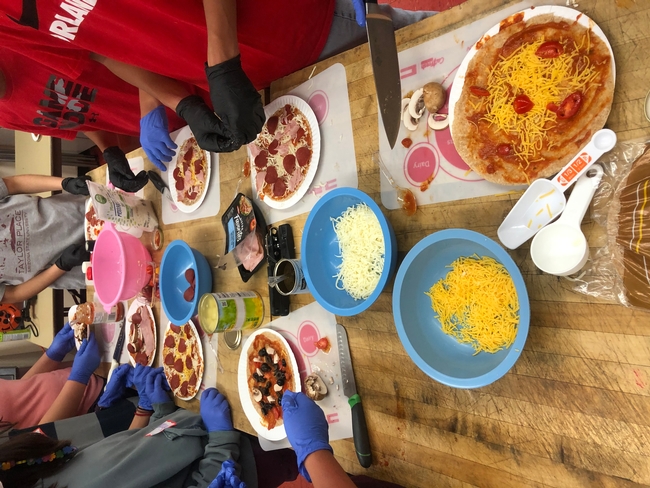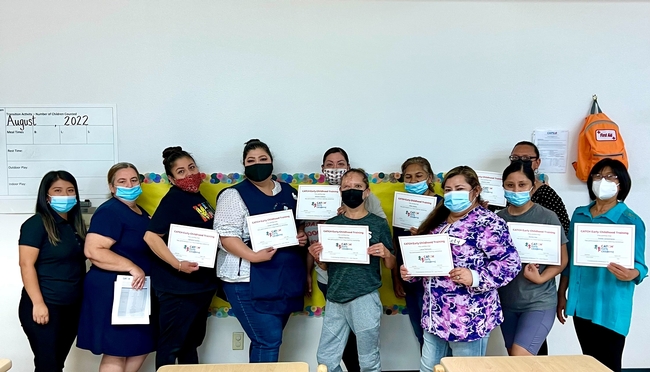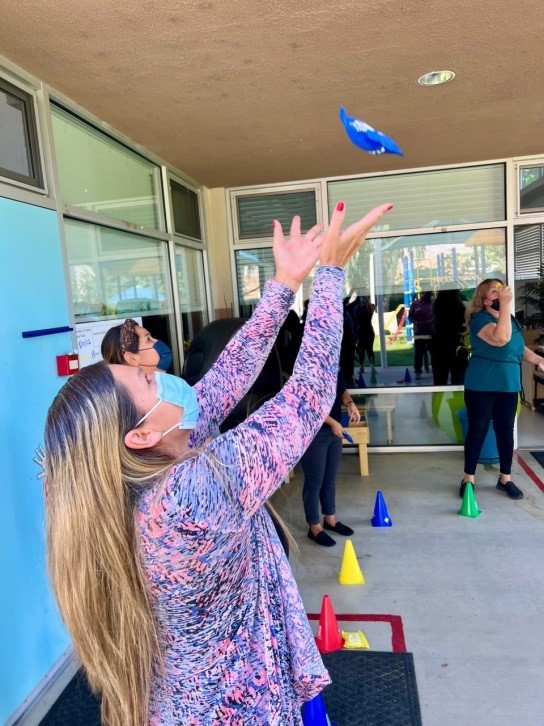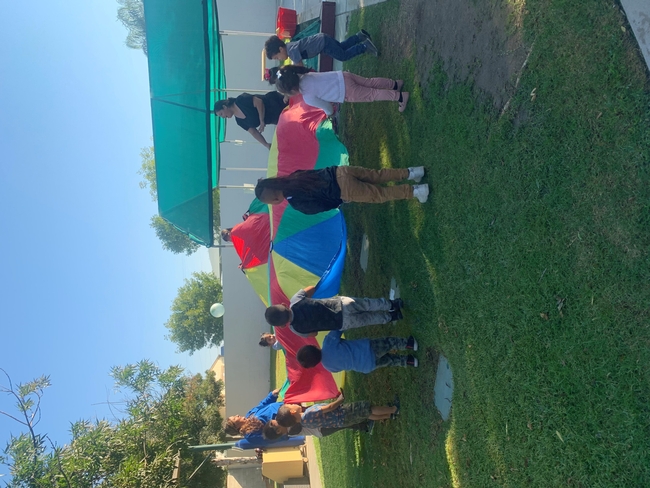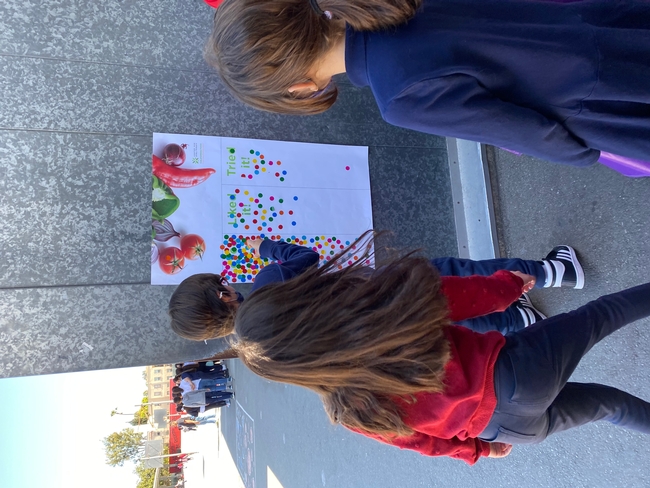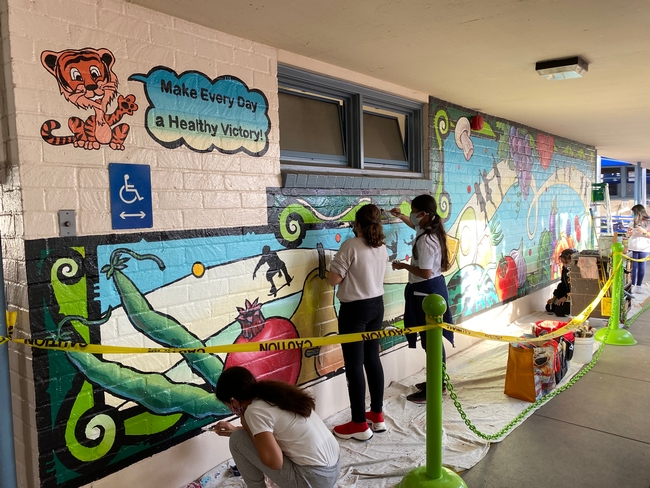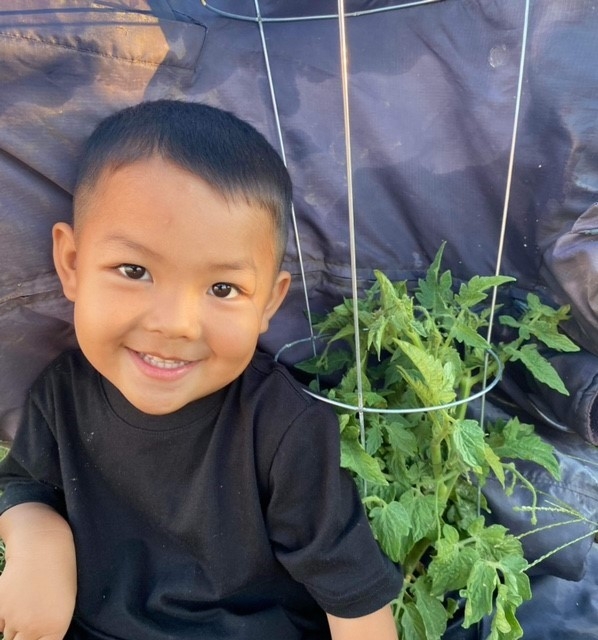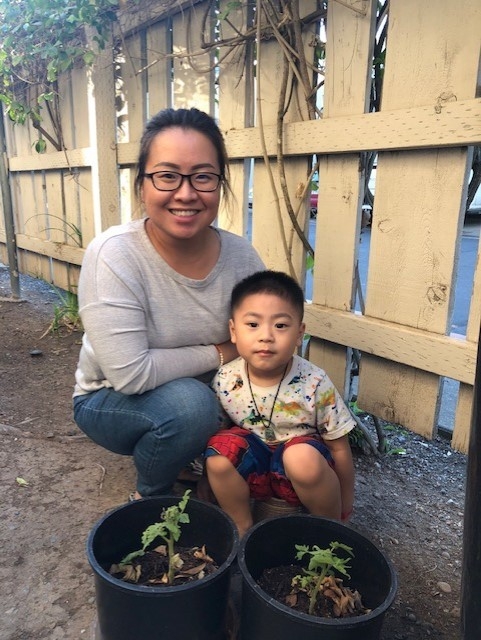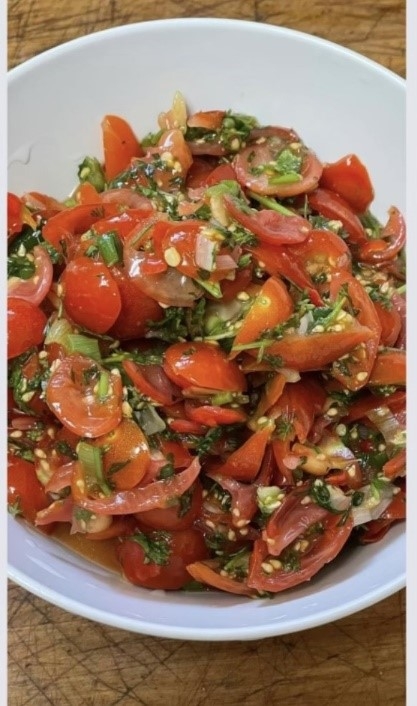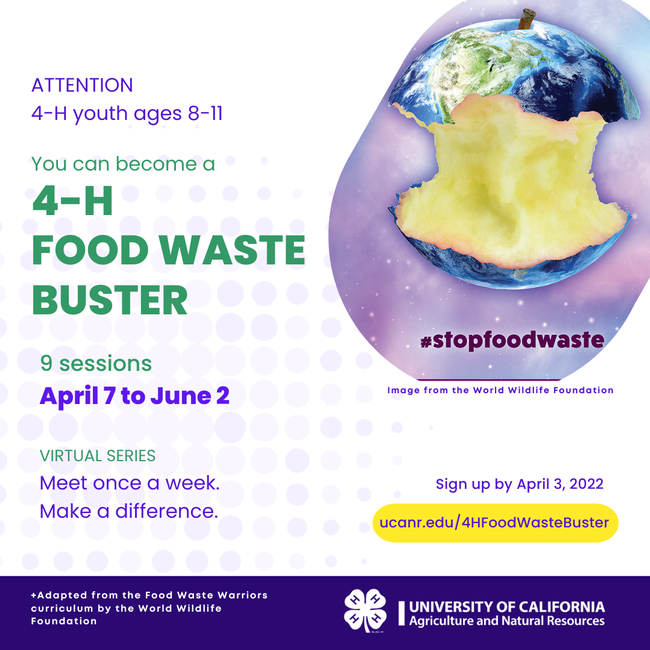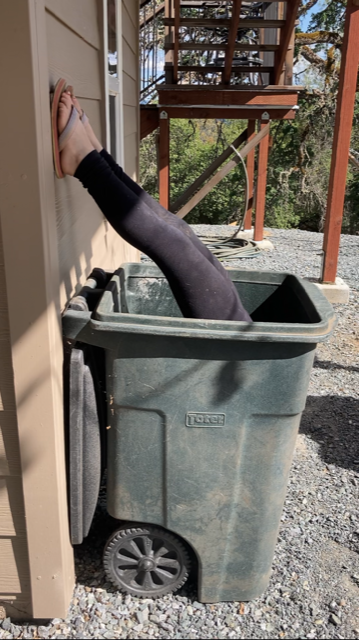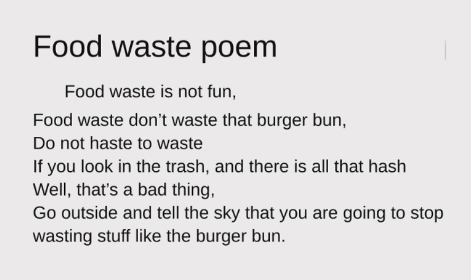- Author: Kelly Hong
- Editor: Mishelle Costa
- Editor: Rosa I Vargas
- Editor: Shannon A Klisch
After attending a Teens Love Cooking summer series focused on nutrition and culinary skills, 83% of youth participants were more willing to try new foods and ask for them at home. The class helped reinforce their healthy eating habits and support their long-term health.
The Issue
Collectively, Santa Maria-Bonita and Santa Maria Joint Union High school districts serve over 25,600 students, with more than half of the students qualifying for free or reduced-price school meals. While schools provide nutritious meals for students, teens, in particular, purchase fast food during non-mealtimes such as after school. Fast food meals are heavily targeted towards youth living in low-income neighborhoods and are typically high calorie foods that contain added sugars, saturated fats, and sodium. Furthermore, 52.1% of youth in Santa Barbara County reported eating fast food two or more times a week. Studies have indicated that children and adolescents who learn how to cook at a young age are more likely to adopt healthier eating practices that follow into adulthood. Eating a healthy diet and getting regular exercise can help reduce the risk of diseases related to poor nutrition and weight management such as high blood pressure, heart disease, and stroke.
How UC Delivers
To address this need, CalFresh Healthy Living, University of California Cooperative Extension in Santa Barbara County (UCCE) partnered with Santa Maria Recreation and Parks (SM R&P) to promote a Teens Love Cooking series to middle school and high school-aged youth throughout the city of Santa Maria. Additionally, SM R&P provided access to a full commercial kitchen, kitchenware, and storage space for program materials. With the support of a SM R&P staff member, UCCE staff met with students for two hours, twice a week over three weeks to teach various nutrition and cooking topics, including knife safety, how to follow a recipe, and how to cook a healthy meal using MyPlate as a guide. Additionally, participants put into practice what they learned by preparing recipes from the Cooking for Health Academy curriculum. As needed, recipes were modified to meet COVID-19 safety protocols when cooking in groups using Eat Fresh and Food Hero. Although some recipes needed to be simplified for COVID-19 safety, each participant was provided ample opportunities to practice and grow their food safety and culinary skills. Lastly, every student took home lesson and recipe information to reinforce the learning and to share with their families.
The Impact
At the end of each session, youth were asked to complete the Teacher Tasting Tool, which measures how willing participants are to consume a particular target food again. After tasting a pizza on a whole wheat tortilla, eight (80%) out of 10 respondents reported that they were willing to eat it again. Additionally, after a separate session where participants tasted a fruit salad made with jicama, 15 (83%) of the 18 respondents reported they were both willing to eat it again and ask for it at home.
At the end of the class series, youth completed the “What Did You Learn” open-ended qualitative survey, which asks about changes in knowledge and behaviors. Ten youth responded to the survey, and for the question related to learning, the theme of improved knife skills and safety was reported most frequently, followed by reports related to increased nutrition knowledge, and increased knowledge of healthy food preparation. When asked about one thing that they do differently because of these classes, students responded with the theme of comfortability using a knife and preparing nutritious foods. When teens are confident in their culinary and nutrition skills, they are more likely to make healthier food choices. Overall, participants gained valuable life skills in culinary, food safety, and nutrition to support healthy choices to reduce the risk of diet related diseases which supports ANR's efforts to promote healthy people and communities.
“I really liked the Oatmeal Bites, so I made them at home for my family to taste”. - high school student
- Author: Beatriz Adrianna Rojas
- Author: Andra Nicoli
CalFresh Healthy Living (CFHL), UCCE Kern County aims to improve health in farm working families by encouraging healthy eating and physical activity. As a result of a partnership with Head Start centers serving migrant communities, youth completed over 140 hours of physical activity and 92% of adult family members intended to use nutrition facts when shopping.
The Issue
According to County Health Rankings & Roadmaps, Kern County is ranked among the least healthy counties in California in terms of length and quality of life and a significant portion of residents have one or more risk factors that threaten their longevity and quality of life. For instance, 34% of adults are either overweight or obese, 35% of residents are physically inactive, and 23% are food insecure.
Children and adults with these risk factors are more likely to develop chronic diseases like heart disease and diabetes.
How UC Delivers
In order to work with residents on early healthy start interventions, CFHL, UCCE Kern County partnered with Community Action Partnership of San Luis Obispo (CAPSLO), which has five migrant Head Start centers in Kern County. CAPSLO provides no-cost childcare and preschool services to low-income families whose primary occupation is agricultural production and harvesting in the Arvin, Lamont/Weedpatch, Wasco, and Delano communities.
CFHL, UCCE Kern has conducted evening adult nutrition education at the centers.
- 94 parents received evidence based lessons from Plan, Shop, Save, and Cook (PSSC) and Healthy, Happy Families.
- Parents learned how to read the nutrition facts label, save money on food and how to start healthy habits with their children. Parents also learned how to incorporate physical activity in their everyday family routine. Physical Activity Guidelines for Americans (2018)recommends moderate-to-vigorous physical activity to reduce the risk of many chronic diseases among children and adults.
In order to impact families CFHL, UCCE Kern provided CAPSLO teachers with four hour training on Coordinated Approach to Child Health Early Childhood Education (CATCH ECE). CATCH ECE provides children with skill development exercises to develop locomotor, non-locomotor, manipulative skills and nurture their love for physical activity through games and activities. Teachers conducted CATCH 2-4 days per week for 30 minutes.
The Impact
Seventeen parents who received the PSSC lesson on understanding food labels completed an “Intent to Change” survey. Results of the survey include:
- Of the 12 respondents who did not use the “Nutrition Facts” label prior to the lesson, 92% reported that they will use the nutrition facts on the food label to choose foods the next time they go shopping.
- A parent shared how the workshop helped her family and that they are “eating better and know how to choose foods with better nutrition.”
From August to October 2022, 130 children participated in 143 hours of physical activity through CATCH ECE lessons delivered by 15 teachers at CAPSLO's centers. Research shows that regular moderate-to-vigorous physical activity reduces the risk of many chronic diseases among children and adults.
“All my children enjoy the CATCH activities. The CATCH program is fun and beneficial,” one teacher shared. The Center Director said “I really like how teachers and children are physically active with CATCH. The nutrition sessions given to the parents also makes it more impactful for the whole family.”
By motivating and teaching CFHL participants to adopt healthier lifestyle practices, and training ECE teachers to support physical activity, CFHL, UCCE Kern helps create healthier families and communities.
- Author: Amanda M Linares
- Contributor: Kaela Plank
- Contributor: Sridharshi Hewawitharana
- Contributor: Gail Woodward-Lopez
- View More...
Nutrition Policy Institute partnered with local health departments to evaluate school-based CalFresh Healthy Living, finding that it improved student diet during COVID-19, contributing to improved community health and wellness.
The Issue
In March 2020 schools across California halted in-person instruction in an effort to protect students and staff against COVID-19 and embarked on “distance learning.” In spring 2021, over half of California's public schools, and disproportionately those serving low-income students, remained in full-time distance learning.
Distance learning had a substantial impact on student food security and dietary intake. Many students lost access to the consistent nutrition provided by school meal programs. Additionally, students may have had increased access to less healthy foods in the home environment, and/or experienced increases in snacking behaviors and eating/drinking out of boredom. For these reasons, continuance of public health programs that operate largely in the school environment, such as the California Department of Public Health's CalFresh Healthy Living (CFHL) program, were essential to addressing health impacts and widening disparities from school closures. When schools shuttered, local health departments (LHDs) administering CFHL had to swiftly adjust their approach to classroom direct education and school-wide policy, system, and environmental (PSE) change strategies as they prepared to deliver and evaluate their school-based interventions from afar. Likewise, evaluators at Nutrition Policy Institute (NPI) needed to devise new methods to enable and support evaluation of this valuable program.
How UC Delivers
To address the need to continue delivery of high quality CFHL programming, LHDs migrated nutrition and physical activity education from delivery in-person to delivery online. Curricula were delivered live via online platforms like Zoom or Google Classroom, or pre-recorded via websites like YouTube. Popular PSE change approaches, like improving school wellness policies or implementing a school garden had limited impact on students if not attending school. With limited or nonexistent in-person school-student interaction, LHDs opted to initiate more feasible and timely PSEs like modifying food distribution practices to ensure students had access to healthy meals.
While LHDs focused on modifying interventions, NPI evaluators were busy adapting evaluation methodology for students learning outside the classroom. A key component of this evaluation involved measuring student eating and physical activity behavior using the Eating and Activity Tool for Students (EATS). Pre-COVID-19, a hardcopy survey was administered to students before and after annual CFHL interventions. In Fall 2020, NPI launched an online version of EATS and provided technical assistance to schools to support virtual administration. Survey questions were also added to capture the unique impact of school closures on students' eating and physical activity behaviors.
The Impact
In 2020-21, pre/post EATS data were collected from 1,087 students from 47 CFHL intervention schools and 846 students from 17 comparison schools- schools where no programming occurred. During this time, intervention students reported a greater increase in frequency of consumption of fruit (by 0.16 times/day; p-value=0.032) and vegetables (by 0.45 times/day; p-value<0.001) than comparison students. Research suggests that higher fruit and vegetable intake protects against the development of cardiovascular and other chronic diseases.
Our findings suggest that LHD-led CFHL programs played a role in protecting student fruit and vegetable consumption during COVID-19 school closures and exemplifies how school-based CFHL may safeguard students' access to and consumption of nutritious food. California's health departments and their school partners proved that even with program adaptations, this important work continued to positively impact student health and wellbeing. Nutrition Policy Institute contributes to UC ANR's public value of Healthy People and Communities through their leadership and support of CFHL evaluation. Efforts by NPI help California communities understand the importance of CFHL programming for their children and families.
Acknowledgments
This study was conducted as part of a contract with the California Department of Public Health with funding from the United States Department of Agriculture (USDA) Supplemental Nutrition Assistance Program-- SNAP. These institutions are equal opportunity providers and employers.
- Author: Veronica VanCleave-Hunt
- Author: Andra Nicoli
- Contributor: Karina Hathorn
A social media campaign aims to improve health of residents at low-income housing sites by encouraging vegetable intake through container gardening
The Issue
In the U.S., vegetable intake is lowest among adults with low income. Eating the recommended daily amount of vegetables is important for overall health. Gardening has a role in promoting vegetable consumption. CalFresh Healthy Living, University of California Cooperative Extension (CFHL, UCCE) Butte Cluster and UC Master Gardeners, kicked off their second annual “Great Tomato Challenge” in 2022, a social media contest for Community Housing Improvement Program (CHIP).CHIP is a non-profit corporation that serves Butte, Glenn, Yuba and Colusa Counties by assisting low-income residents with quality, affordable housing. The goal of the “Great Tomato Challenge” event is to promote container gardening at apartment complexes through a workshop and social media contest.
How UC Delivers
The 1.5 hour Fresh from the Garden curriculum workshops took place at 5 CHIP sites, having been advertised in English, Spanish, and Hmong language flyers. Over 40 adults learned how to harvest, store, and prepare fresh tomatoes. Those who opted to sign up for the social media challenge received a tomato plant and agreed to submit photos, drawings, and recipes accessed on the CFHL, UCCE Butte Cluster Facebook page.
UC Master Gardeners partnered with CFHL, UCCE Butte Cluster to provide Facebook Live sessions to answer any questions participants had about growing their tomato plant. CFHL, UCCE Butte Cluster Educators translated questions and answers into Spanish and Hmong.
Three winners were selected from the 36 contestants from the following categories: best photo of you and your tomato plant; best tomato drawing; and best recipe photo. Winners received a colander, whole wheat spaghetti noodles, and a jar of locally-sourced pasta sauce.
The Impact
Eighteen participants completed an "Intent to Change" Survey for the workshop. Thirty-eight percent reported that they would: “eat more than 1 kind of vegetable each day more often within the next week.” One participant wrote “This workshop helps my family to be healthier.” Gardening has a role in promoting greater vegetable intake and variety among families with low income which improves overall health.
CalFresh Healthy Living, UCCE Butte Cluster will continue this challenge annually and is considering starting an additional annual challenge, using the same model, for a cool-season vegetable such as beets.
- Author: Yu Meng
- Author: Dorina M Espinoza
- Author: Marisa Neelon
In response to CA SB1383, the 4-H Food Waste Busters Project provides an opportunity for youth to engage in reducing household food waste and help combat climate change.
The Issue
Household food waste is a major problem in the U.S. and the average U.S. household wastes 31.9% of the food it buys, with an estimated value of $240 billion. Food scraps, yard trimmings, and other organic waste make up half of what Californians add to the landfills. Greenhouse gases released by decomposing food and yard waste contribute to climate change. To respond to this issue, California is implementing statewide organic waste recycling and surplus food recovery. California's short-lived climate pollutant reduction strategy (SB1383) aims to reduce organic waste disposal 75% by 2025. This goal requires every Californian to take action. Household food waste is a complex and multifaceted issue and is affected by food-related practices (planning, shopping, storing, cooking, eating, and managing leftovers). Consumers' misunderstanding of food date labels is associated with more frequent food discards and effective educational communication is needed for consumers to understand their meaning. Educating consumers about strategies to reduce household food waste will support their compliance with SB 1383.
How UC Delivers
Extension can play a part in addressing household food waste reduction efforts. There is a call for giving children and young people a 'voice' and a 'hand' in redressing climate change. We chose to tackle this problem through the 4-H youth development program. The 4-H program is grounded in the belief that youth learn best by doing hands-on learning in a positive environment and are encouraged to take on proactive leadership roles. Increasing youth awareness and knowledge about the issue can engage them in food waste reduction and potentially influence a larger community. Youth in 4-H can highlight the issue through club projects, community service, public speaking opportunities, and civic engagement.
The 4-H Food Waste Busters Project's aim was to increase knowledge and understanding of the issue of food waste and its importance in the ecosystem. Through 4-H experiences, youth develop the knowledge, skills, and attitudes needed to live a sustainable lifestyle. This project helps youth better understand how making small changes can make a difference in their home, club, and community. As a result, youth can describe what food waste means; explain the benefit of reducing food waste; conduct a food waste audit at home; and encourage household members to adopt strategies to reduce food waste.
UC ANR Advisors adapted a food waste school curriculum developed by the World Wildlife Fund into age-appropriate, inquiry-based online lesson plans that fit the 4-H project format. Since many students were still engaged in online learning as a result of the COVID-19 pandemic this created an opportunity to focus on household-level food waste. The 4-H lesson plans provided time for team building, group agreement development, activity exploration, a capstone project, and reflection. The Advisors piloted the lesson plans with fourteen youth members through 9 weekly one-hour zoom project meetings. At the end of the pilot project, Advisors conducted a focus group with the youth to confirm that our project aims were fulfilled and to provide an opportunity for them to give feedback on the lesson plans.
The Impact
The 4-H youth were able to articulate their favorable response to the project. Youth learned about food waste's impact on the environment and strategies to reduce household waste. They shared the changes they or their family made because they participated in the project. “We realized how much food we wasted and we're trying to waste less; we are trying to have one meal of leftovers every week; we stopped cooking so much food so we don't have so many leftovers that would go to waste; we buy less food unless we really need it.” One youth shared: “This project made me realize how much food we're wasting, how much I could do about that and how much impact we're having on the world.” At the end of the project, youth completed capstone projects (poem, slide show, fact sheets) to share and educate their peers and family about food waste reduction strategies. Based on the successful pilot, we developed an online training for California 4-H project leaders. Fourteen volunteers completed project training and 78% reported that they are definitely more confident in leading this project.
Components of the 4-H Food Waste Buster's project were intentionally created to help youth identify their household level of food waste and to develop strategies to reduce overall food waste including using left-over foods. The lessons also reinforced the importance of composting food instead of throwing it away. These experiences then contributed to conversations and learning about how household level behaviors can impact local, state, national and global levels of food waste and the environmental impacts of greenhouse gases that are produced in landfills.
The 4-H Project material was shared through the volunteer training and is in the process of ANR peer review. Once published on the ANR 4-H project sheet website, volunteers and educators from California and all land-grant universities in the U.S. will have free access to our lesson plans to deliver similar projects through their Cooperative Extension 4-H programs.
Tips to Reduce Food Waste



